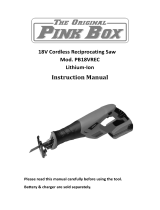
5
WARNING: Fire hazard. Never attempt to open the battery pack for any reason. If
battery pack case is cracked or damaged, do not insert into charger. Do not crush,
drop or damage battery pack. Do not use a battery pack or charger that has received
a sharp blow, been dropped, run over or damaged in any way (i.e., pierced with a nail,
hit with a hammer, stepped on). Damaged battery packs should be returned to service
center for recycling.
WARNING: Fire hazard. Do not store or carry battery so that metal objects can
contact exposed battery terminals. For example, do not place battery in aprons,
pockets, tool boxes, product kit boxes, drawers, etc., with loose nails, screws,
keys, etc. Transporting batteries can possibly cause fires if the battery terminals
inadvertently come in contact with conductive materials such as keys, coins,
hand tools and the like. The US Department of Transportation Hazardous Material
Regulations (HMR) actually prohibit transporting batteries in commerce or on
airplanes (i.e., packed in suitcases and carry-on luggage) UNLESS they are properly
protected from short circuits. So when transporting individual batteries, make sure
that the battery terminals are protected and well insulated from materials that could
contact them and cause a short circuit.
SPECIFIC SAFETY INSTRUCTIONS FOR LITHIUM ION (Li-Ion)
• Do not incinerate the battery pack even if it is severely damaged or is
completely worn out. The battery pack can explode in a fire. Toxic fumes and
materials are created when lithium ion battery packs are burned.
• If battery contents come into contact with the skin, immediately wash area
with mild soap and water. If battery liquid gets into the eye, rinse water over the
open eye for 15 minutes or until irritation ceases. If medical attention is needed,
the battery electrolyte is composed of a mixture of liquid organic carbonates and
lithium salts.
• Contents of opened battery cells may cause respiratory irritation. Provide
fresh air. If symptoms persists, seek medical attention.
WARNING: Burn hazard. Battery liquid may be flammable if exposed to spark or
flame.
Important Safety Instructions for All Battery Chargers
SAVE THESE INSTRUCTIONS: This manual contains important safety and operating
instruc tions for battery chargers.
• Before using charger, read all instructions and cautionary markings on charger,
battery pack, and product using battery pack.
WARNING: Shock hazard. Do not allow any liquid to get inside charger. Electric
shock may result.
CAUTION: Burn hazard. To reduce the risk of injury, charge only DEWALT
rechargeable batteries. Other types of batteries may burst causing personal injury and
damage.
NOTICE: Under certain conditions, with the charger plugged in to the power supply,
the charger can be shorted by foreign material. Foreign materials of a conductive
nature such as, but not limited to, grinding dust, metal chips, steel wool, aluminum
foil, or any buildup of metallic particles should be kept away from charger cavities.
Always unplug the charger from the power supply when there is no battery pack in
the cavity. Unplug charger before attempting to clean.
• DO NOT attempt to charge the battery pack with any chargers other than the
ones in this manual. The charger and battery pack are specifically designed to
work together.
• These chargers are not intended for any uses other than charging D
EWALT
rechargeable batteries. Any other uses may result in risk of fire, electric shock
or electrocution.
• Do not expose charger to rain or snow.
• Pull by plug rather than cord when disconnecting charger. This will reduce risk
of damage to electric plug and cord.
• Make sure that cord is located so that it will not be stepped on, tripped over,
or otherwise subjected to damage or stress.
• Do not use an extension cord unless it is absolutely necessary. Use
of improper extension cord could result in risk of fire, electric shock, or
electrocution.
• When operating a power tool outdoors, use an extension cord suitable for
outdoor use. Use of a cord suitable for outdoor use reduces the risk of electric
shock.
• Do not place any object on top of charger or place the charger on a soft
surface that might block the ventilation slots and result in excessive internal
heat. Place the charger in a position away from any heat source. The charger is
ventilated through slots in the top and the bottom of the housing.
















